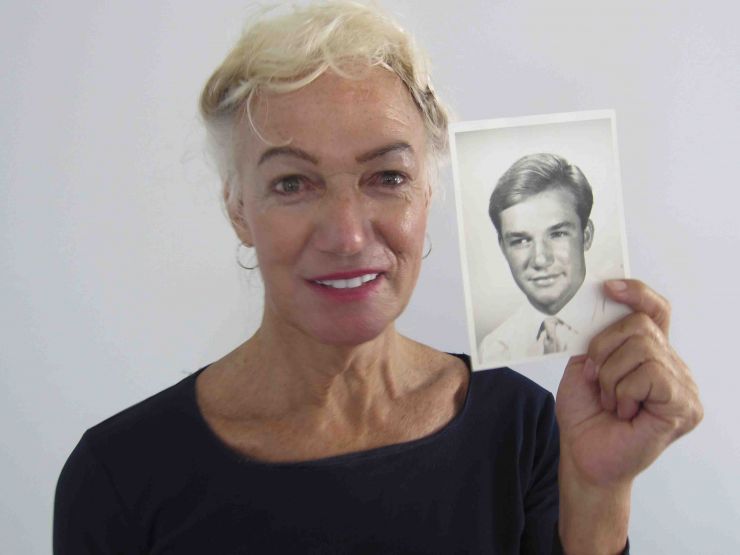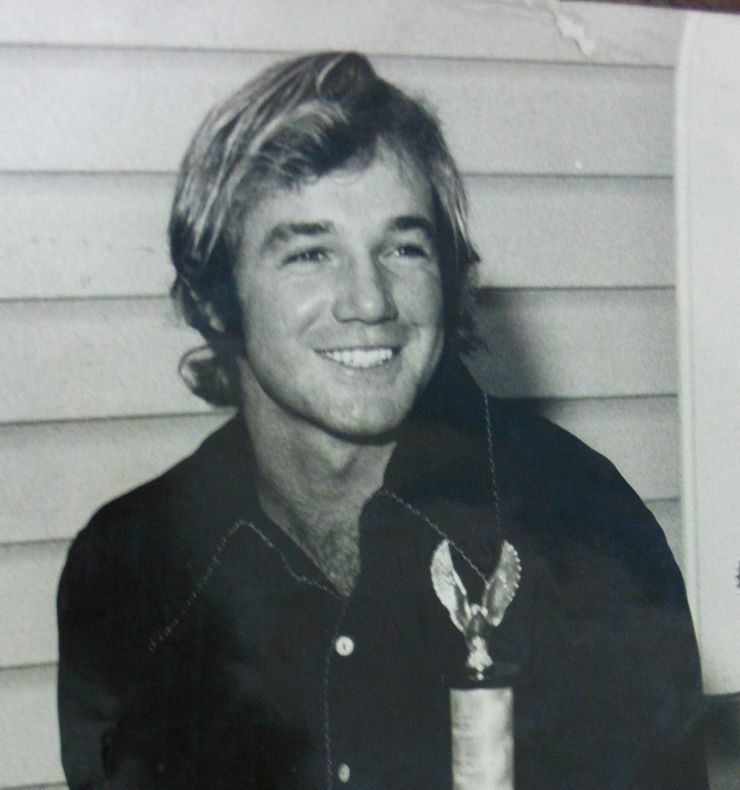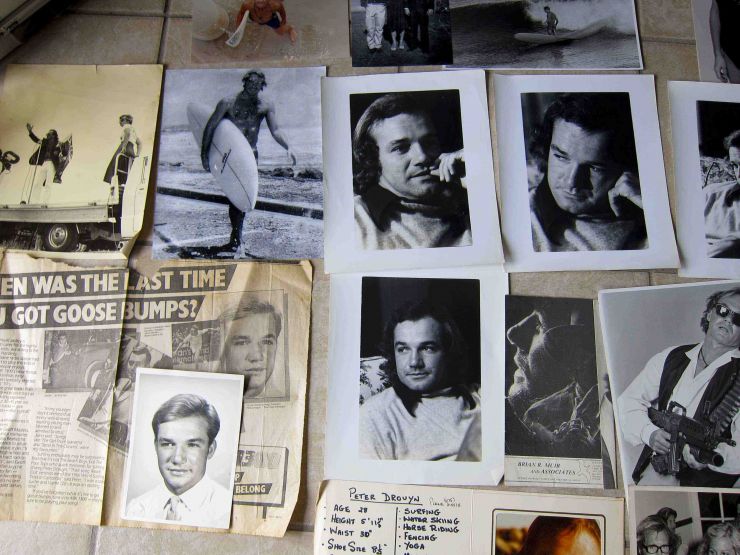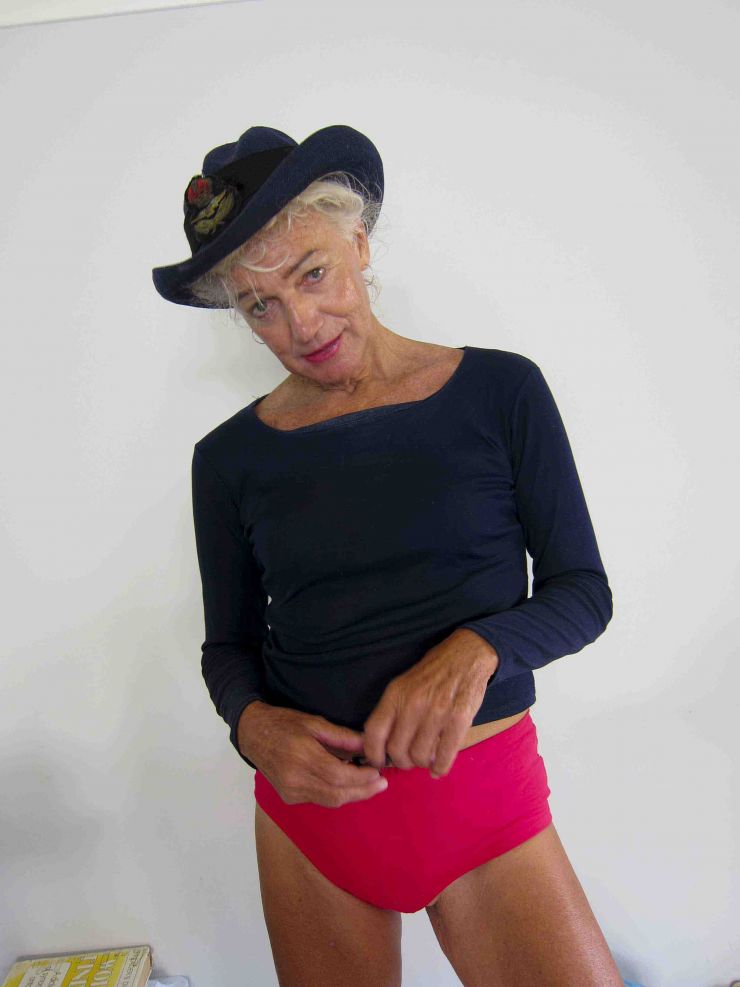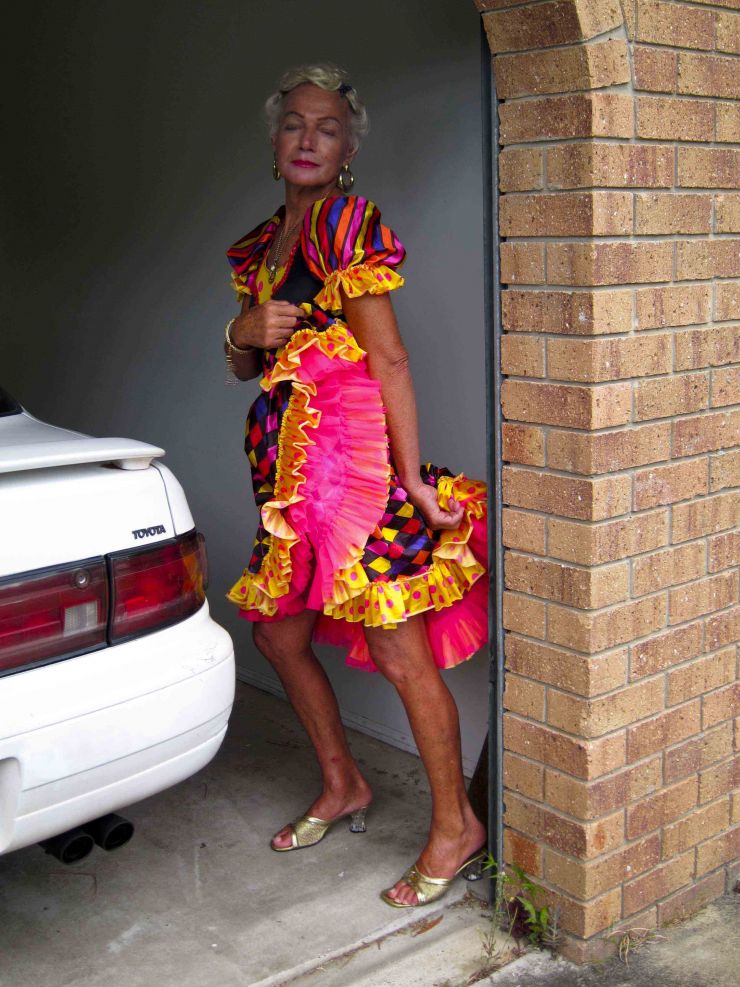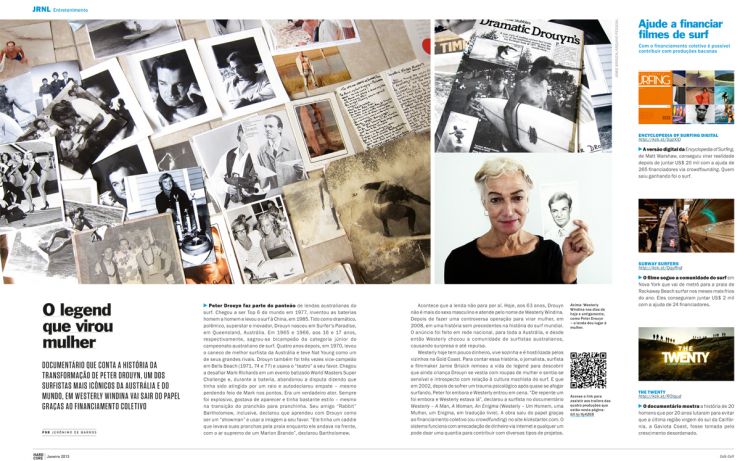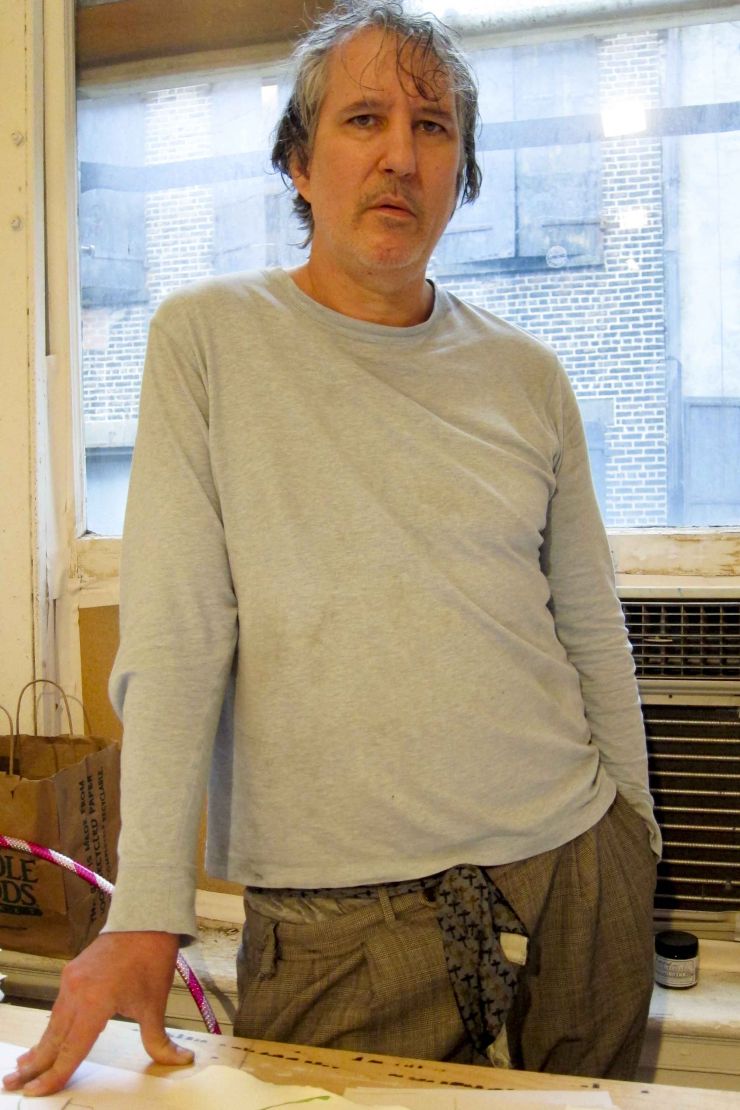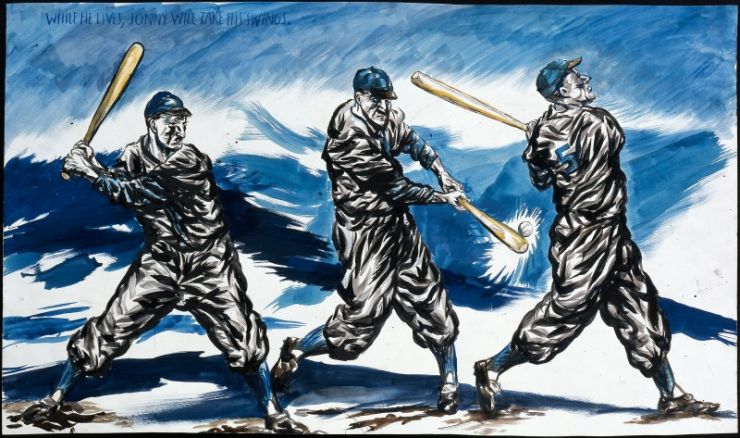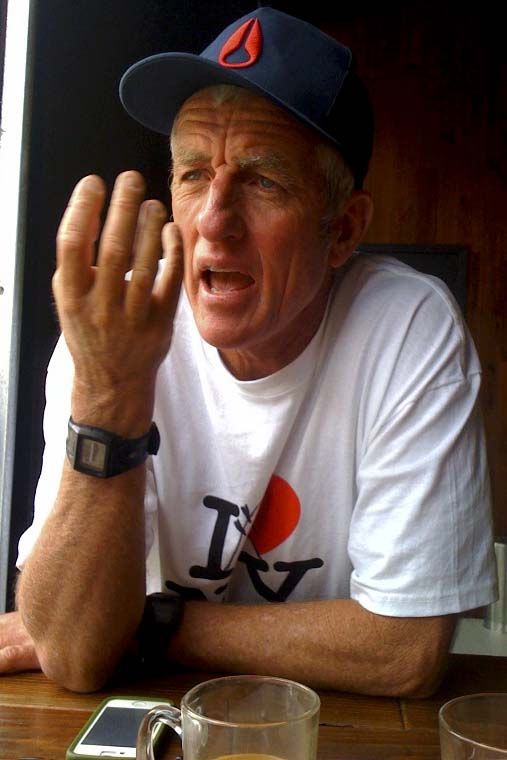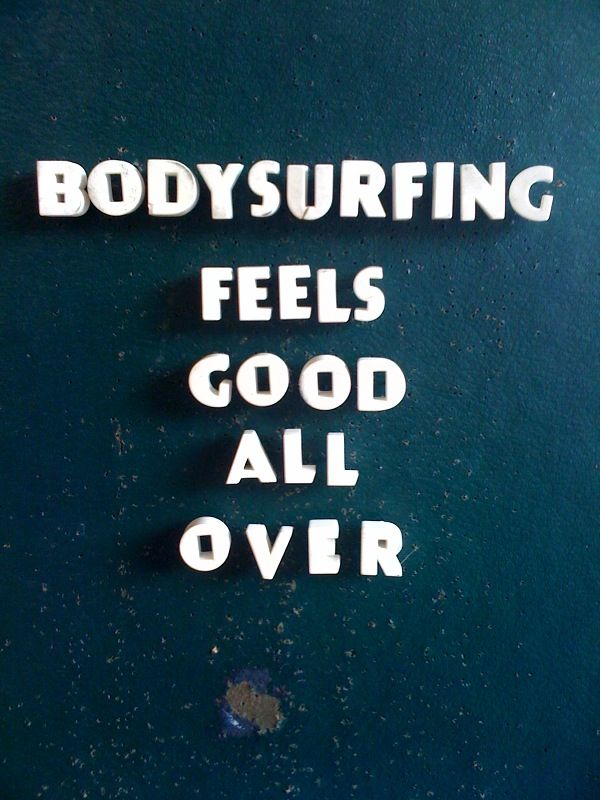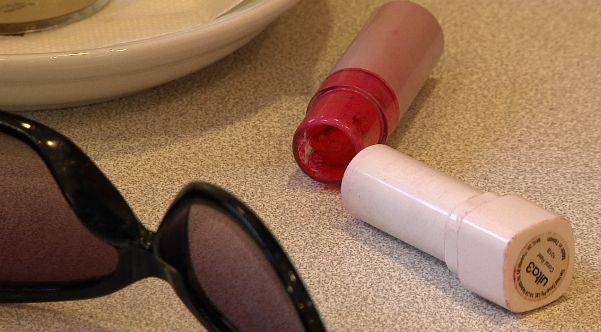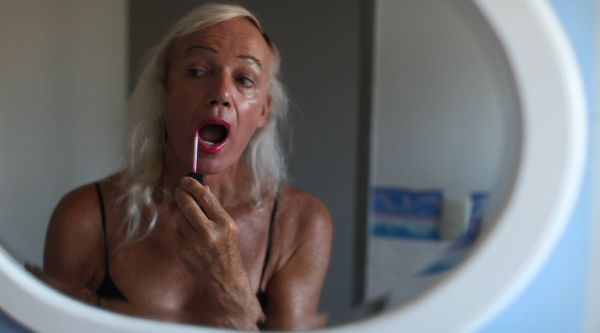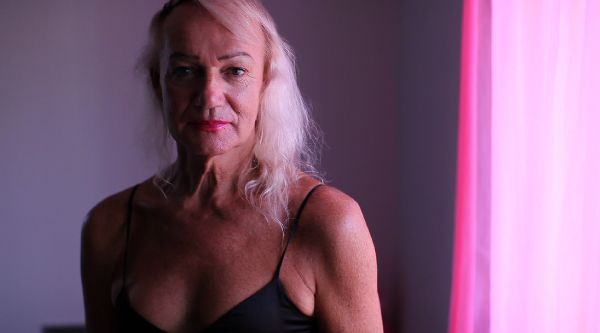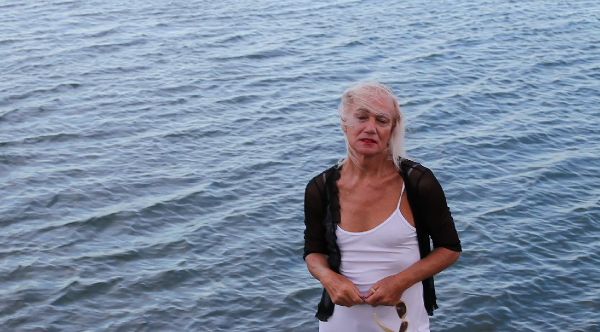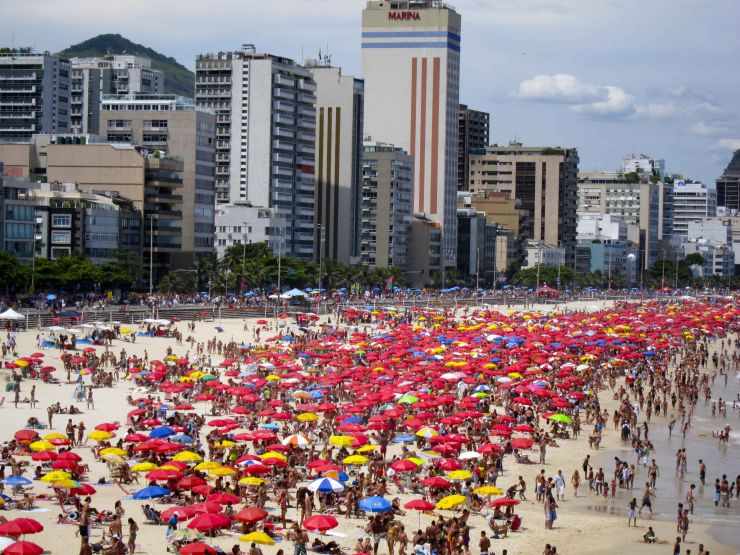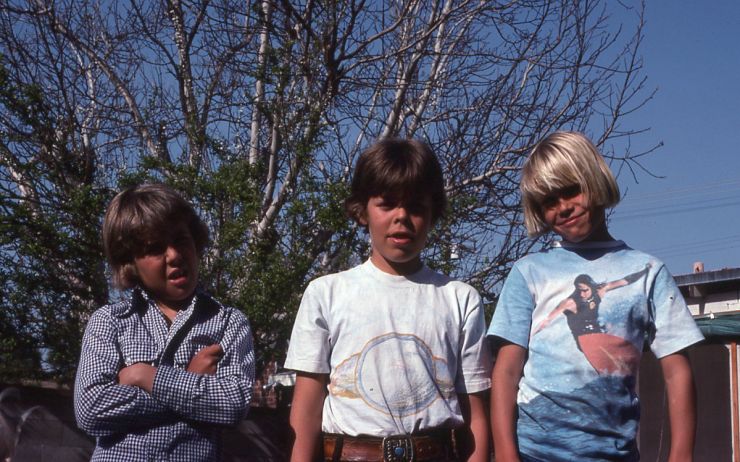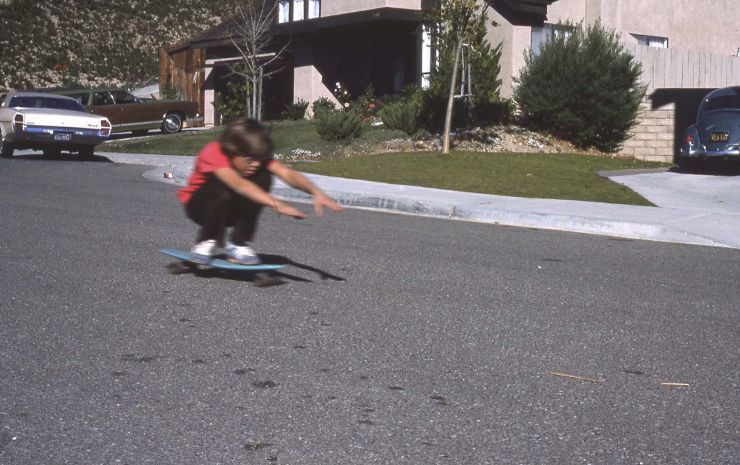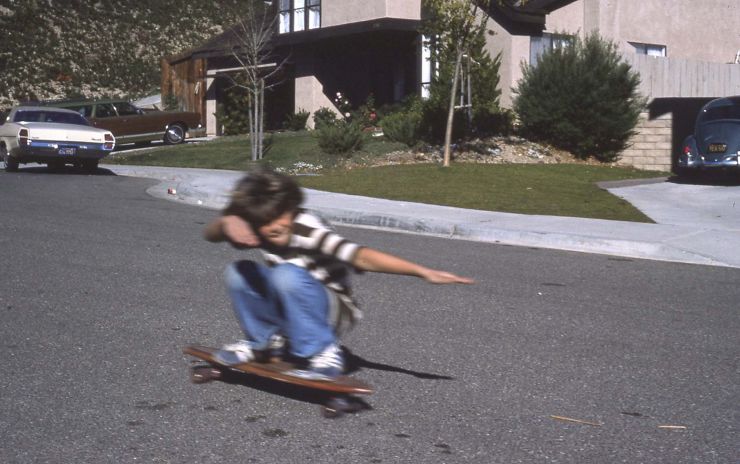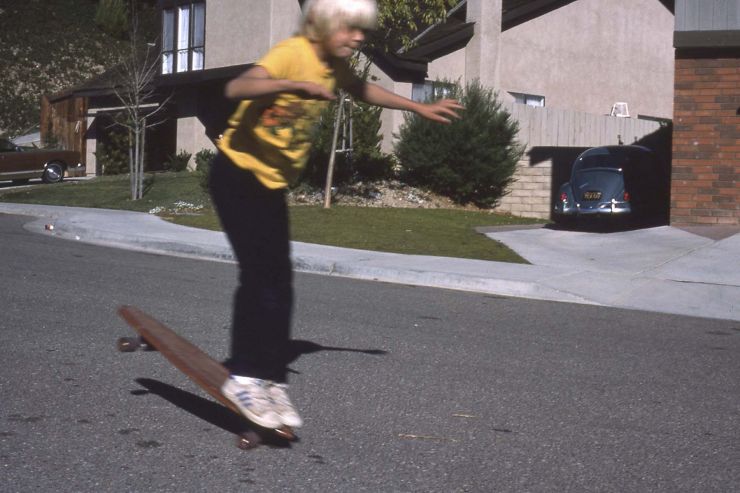Westerly Windina peers into a vintage hand mirror and applies ruby red lipstick to her puckered lips. She wears a white blouse, red Bolero jacket, black slit skirt, black-and-white Chanel-style ballerina flats, and gold chunk jewelry. She sits with her back straight, elbows off the table. From one angle she looks like a sex kitten, from another, someone’s grandma. She is the former Peter Drouyn, or Drouyn’s alter ego, or a magnificent publicity stunt, at this point I’m still unsure.
What I do know is that in 2008, Australian surf legend Peter Drouyn announced on national television that he was living as a woman. She said that this had been brewing in Peter for a long, long time. She mentioned taking hormones in preparation for gender reassignment surgery, which she hoped to undergo in the near future. Her new name, she said, was Westerly Windina.
As a young surfer coming of age in the ‘80s, I’d missed Drouyn’s heyday. But I’d heard stories: that he was Queensland’s first surfing superstar; that he’d invented the man-on-man contest format; that he was theatrical and enigmatic and deeply embittered that surf historians hadn’t given him more credit. In the film Bustin’ Down The Door, ’78 world champ Wayne ‘Rabbit’ Bartholomew describes Drouyn riding the pristine tubes of Kirra as “the best display of surfing I’ve ever seen in my life.” When the Westerly story broke I became instantly fascinated. I searched the Internet and found various accounts, but aside from the basics, none of the pieces I read attempted to get beneath the surface. Most treated her as a freak show.
When I telephoned Westerly to request an interview she was first suspicious then charming and hospitable. We meet at an Italian trattoria near Surfer’s Paradise, on Australia’s Gold Coast. In the five slightly strained minutes between shaking hands out front, entering the airy restaurant, being shown to our table, and ordering drinks (ice water for both of us), it becomes very apparent that Westerly is far more female than male. In fact she’s almost Southern Belle-ish in her politeness and delicate mannerisms. I’m struck with the urge to open the door for her, pull out her chair. Should a mud puddle suddenly appear in our path I’d doubtless throw down my T-shirt. I’m also walking on eggshells. I have a long list of deeply personal questions that seemed perfectly legitimate when I rehearsed them on the ride here, but now seem suddenly inappropriate. Westerly, however, gets right to it.
“This is the unfolding of someone experiencing—“ she says in a soft, breathy tone, then pauses, looks down to her hands, folds one atop the other. Her mascaraed eyes search the table, a wisp of platinum blonde hair curls like a perfect wave across her forehead. “I’ll think of the words in a second.”
She takes a sip of water, collects herself. “This is the unfolding of someone experiencing a new existence. I’ve been plucked and put into a new dimension. This is actually something that has come and hit me and said, ‘You’re ready. You’re ready to enter this new space and time and there’s a mission for you in all this.’ It sounds weird, I know. I keep saying to people, ‘It’s not intentional.’ This girl is just—wow! She’s out there, but she’s real. And I don’t want to get out of it. And I can’t get out of it.”
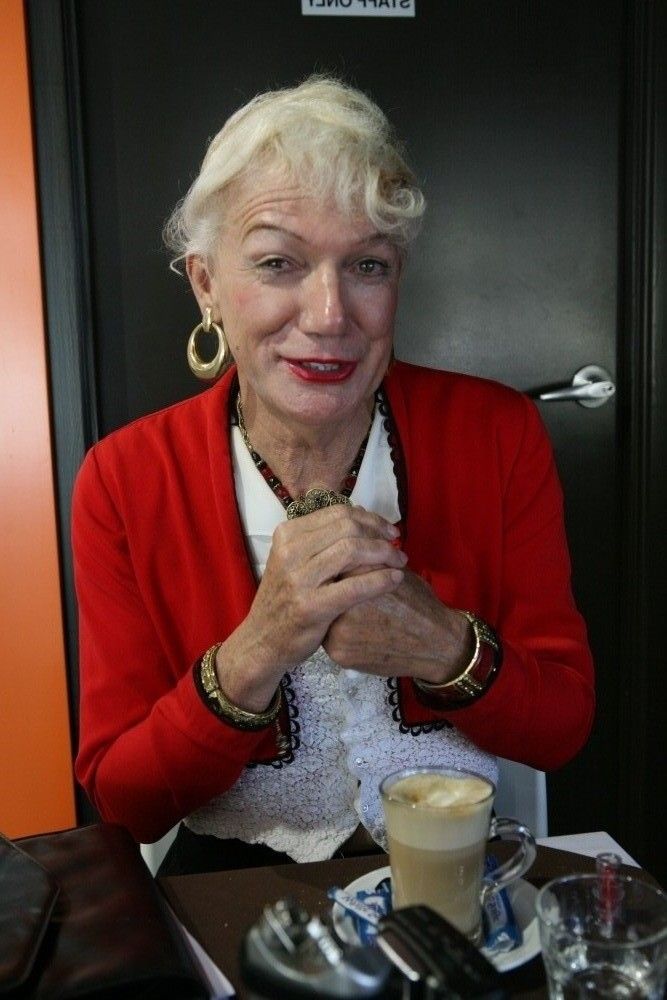
Peter Drouyn was born in 1950, and spent his early years frolicking on the beaches of his hometown, Surfer’s Paradise. His father, Victor, was a lifeguard/clothing store owner and played saxophone in a big band. His mother, Gwendolyn, was a singer and pianist. Drouyn and his older brother, Anthony, grew up in a middle class home with Catholicism and creativity at its center. Before Peter was born his mother’s obstetrician told her that she was pregnant with a girl.
At age eleven, Peter was playing in the shorebreak when a Sydney surfer streaked past on a long balsa board. Peter asked if he could try it, stood up on his first wave, and proceeded to hijack the board for the next couple of hours. He surfed his first contest in ‘65: the Cadillac Classic at Greenmount Beach. Suffering from a bad case of nerves in the final, he finished fourth. Later that year he won the Queensland Titles, which earned him a round-trip plane ticket to Sydney for the prestigious Australian National Titles.
Fifteen-year-old Peter flew to Sydney with big aspirations. On the eve of the event, after a competitor’s meeting at Manly Hotel, a trio of surfers humped him. Two held his arms while the third—“a redhead with freckles, I can still see him”—bashed him in the face, the stomach, the ribs. When they finally let go he fell like a ragdoll, his head slamming the street. A fellow competitor found him in a pool of blood and rushed him to hospital. He received twelve stitches in his forehead and four in his lip. The doctor told him to stay out of the water, but Peter convinced him to cover his cuts with a liquid bandage. He went back to his hotel, smeared a bar of paraffin up and down his surfboard, and anxiously awaited daylight.
The following morning he went out and won his first heat—and every heat thereafter. It was a sweet victory. Not only did he exact the perfect revenge on his assailants, but he became an overnight sensation in Australia’s fledgling contest scene.
Standing on the podium in front of a small sea of applauding fans and popping flash bulbs, he felt like the heavyweight champion of the world.
Westerly politely orders a spaghetti arrabiata with calamari from our stout, simpatico waitress who calls both of us “doll.” She passes back her menu, tells me “the arrabiata is to die for,” and rolls her eyes. I order the same, then quickly scan the room. Our fellow diners are a mix of white-collar businesspeople, manicured housewives, and old ladies sipping coffee. I mention something about suburbia being a haven for narrow-mindedness and Westerly says that Australia is an “insensitive, backwards-thinking culture.” She talks about the tall poppy syndrome, an Australian phenomenon in which mediocrity is championed and excellence and eccentricity get chopped down. ”Peter was an awkward misfit,” she says. “He had to do it all himself when he wasn’t really a fighter or a swearer or a beer drinker. His life was a lie.”
I ask what ‘Westerly Windina’ means and she explains that the westerly wind is offshore on the Gold Coast, and that these were Peter’s preferred surfing conditions. I gently ask whether she’s had gender reassignment surgery. “It doesn’t matter,” she says. “Let’s just say that you’re getting around as a girl who was a boy. You’re dressing up as a girl because you know genuinely that you’re a girl. So it really doesn’t matter if you’re walking around with testicles and a penis. It’s tantamount to the testicles and penis being foreign to you. They shouldn’t have been there! It shouldn’t be there! And you’ve got to get them off as soon as possible. It’s like a leech that has gone into your body and you’re trying to rip it out but half of it’s stuck. You don’t want it there. It’s foreign.” She takes a sip of water. “So if you take that thought through, it really doesn’t even matter if you’re walking around as a girl with penis and testicles. If you know you’re a girl, and you’ve got the operation coming, so what? Yeah, you’re a girl anyway.”
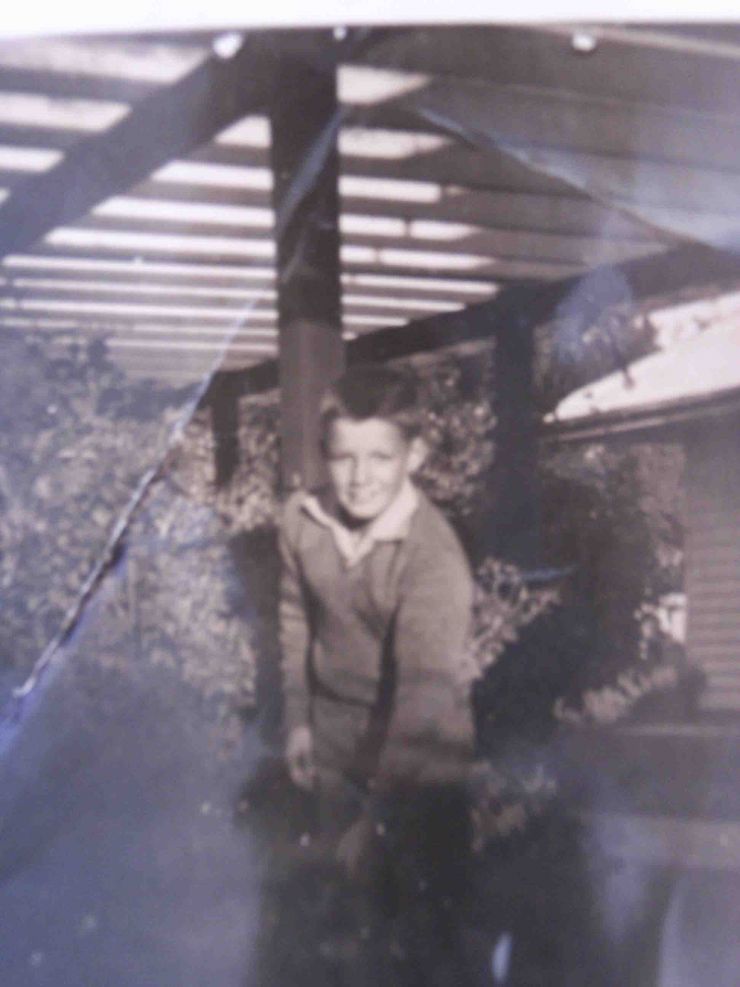
Peter loved cowboy and Indian movies as a kid, and would slip off to a private corner of his backyard and reenact scenes, only instead of playing the cowboy, he’d paint his fingernails and put on lipstick and a miniskirt and play the squaw. He adored flowers—smelling them, rubbing them on his face, wearing them in his hair. He wore women’s boardshorts in the surf for their “tight, slender fit.” While watching his first surf film on the big screen, featuring the massive, thundering waves of the North Shore, he was so viscerally moved that he had to hide behind his seat. “He looked like a boy,” says Westerly, “but his emotions and sensitivities were like a girl.”
His first “crosswiring”—“the start of Peter becoming afraid of himself”—came at age eleven. Westerly was reluctant to go into detail, but from what I could glean, Peter and a young girl slipped off to a nearby lake for hanky-panky. They were kissing, groping, dry humping, when Peter came in his pants. He spiraled into a horrific panic. “His Catholic guilt came out,” says Westerly. “He thought he’d gotten her pregnant. He thought God would damn him, that he’d go to hell.”
More panic attacks followed. He became increasingly shy and mistrustful. He couldn’t concentrate in school, and eventually stopped going altogether. His parents sent him to a psychiatrist. Westerly insists that Peter suffered from severe OCD (obsessive-compulsive disorder), but at the time doctors had yet to diagnose it as such. He was prescribed medication.
And then surfing came along.
Whether a form of salvation or a wedge between Peter and his true self is open to conjecture. One thing’s for sure: he was spectacularly gifted on a board. While his contemporaries did walkovers and hang fives, Peter heaved up and down, back and forth, pioneering what the Aussies dubbed the “power style.” He could lose himself on a wave; apply every nerve, every cuticle. “It was a rebellion thing,” he said in a ’97 issue of Deep. “I powered. I had to get it out of me. I’d punch the wave.”
After winning three Australian National Titles, Peter set off on a world tour that included the big waves of the North Shore, where he won the Makaha Invitational, placed 4th in the Smirnoff and 2nd in the Duke Invitational. It was a terrific run, but a series of misfortunes left him feeling spurned and ostracized. In the ’68 World Titles in Puerto Rico, he fell deathly ill, and got no help from fellow competitors or contest officials. In the ’70 Duke event, he was told by everyone but the judges that he’d won. At the dawn of the Shortboard Revolution he shaped himself a board that was hugely instrumental in sparking this quantum leap—but the surf media ignored him.
“Politics and injustice worked against poor Peter,” laments Westerly. “He was devastated by how they sidelined him. They forced him into exile.”
Lunch arrives, and without asking, our waitress grates a coating of Parmesan over Westerly’s pasta. Westerly shudders. She gives me a distressed look. When our waitress walks away she tells me she can’t eat cheese; that the doctor said to steer clear of it. After brief deliberation, and triple-checking that I won’t think her a prima donna, she takes it back for a new plate.
We discuss decorum and etiquette, the lack of lady-like role models in pop culture, and the importance of style and good taste. She tells me that her friends—“I don’t have many close friends”—were first taken aback by Westerly, but are now “getting used to her, and actually treating her as a girl without even realizing they’re doing it.”
I’m fascinated by her repeated use of the third person. It feels theatrical; as if Peter and Westerly are characters she’s playing in a movie. What’s more, she’ll often mix pronouns then correct herself: “...I was devastated, I mean, Peter was devastated.” She is a protean conversationalist, bouncing from old Hollywood films to Aboriginal history to “the monsters that robbed poor Peter” in a single breath. She’s also prone to great bursts of laughter in which her eyes go glassy and cheeks turn rosy.
I ask about surfing and she says that she surfs “when there’s a quiet, empty wave” but avoids the popular beaches because “Australian surfers get around in packs, and have a tendency toward violence.” I ask if her connection with the water has changed. “I see the whole environment as being beautiful,” she says. “I see a wave—I don’t necessarily want to go out and surf it, I just love the way it curls over and breeches and sprays; the colors, the noise, the way it just dissipates on the shore.”
There is a delightful sense of wonder about Westerly. She seems genuinely gracious and awestruck and childlike. I ask who her heroes were growing up and she mentions Muhammad Ali, Juan Belmonte the famous Spanish bullfighter, and—
“You’re not going to believe this, but Marilyn Monroe in River of No Return and The Seven Year Itch and Bus Stop. And I was disappointed in The Misfits!”
In 1971 Peter enrolled in the National Institute of Dramatic Art (NIDA) and studied Stanislavski’s system—an approach in which actors draw upon personal emotions and memories, and immerse themselves fully in their characters. Peter was a natural. He acted in plays, films, and television commercials. He learned about movement. “He went from being a gorilla to style and elasticity,” says Westerly.
His theatrical side seeped into his surfing. At contests he’d show up with a six-foot-four, top hat-wearing caddy named Johnny Walker, who tended to Peter the way a second tends to his boxer. To be interviewed for Surfer he charged a fee. At parties and awards presentations he’d perform skits, race calls, and impersonations, most famously Brando in The Godfather, in which he’d stuff his cheeks with tissue paper.
He came up with “Method Surfing.” “I styled it off what I learned at NIDA: the Stanislavski-method style of acting,” he said in a 1980 issue of Surfer. “That is, you are one and the same, you become the ocean by degrees of concentration and relaxation, kind of a hypnotic state...I went out and just became the ocean.”
In 1973, Peter and a filmmaker set off on a six-month around-the-world odyssey, chasing waves along the coasts of Mauritius, South Africa, Angola, the Canary Islands, Morocco, Hawaii, Japan, and Indonesia. The resulting film, Drouyn, captures Peter at the height of his powers. The Peter on-screen bares no resemblance to the tortured, introspective Peter that Westerly describes. He charms topless Angolan tribeswoman, kisses giggly Japanese girls, and swaggers naked across the beach in Biarritz. Most riveting is his exuberant “Method Surfing.” With a fluid stance and cocked front arm, his off the bottom/off the top combos are vicious and almost dizzying to watch. He is profoundly at one with the wave.
Peter arrived home from the trip ecstatic, transformed, convinced that the film would blow minds. The premiere was held in a wine cellar in Sydney. Peter wore a yachtsman’s navy blazer and flared white slacks. After the screening, he hopped up on stage and launched into what Tracks journalist Phil Jarratt called “a stream of consciousness rave that incorporated every nuance of manic brilliance that he’d picked up in bars around the world, The National Institute of Dramatic Art, and a decade in the jetstream of international surfing.” He went on to say that “Peter Drouyn is the personification of what surfing is all about and...deserves to be as important a figure in sport as Muhammad Ali.”
Nevertheless, Drouyn flopped. Audiences didn’t get it, nor did the magazines. Even worse, they largely ignored it. Peter’s sense that the surf media was conspiring against him grew. He fell into a crippling two-year depression.
Things turned around in 1976, when the general manager of Australian clothing giant Stubbies asked Peter to mastermind a surf contest. Drawing from his love of acting and boxing, he came up with the man-on-man format. At press conferences he called the existing four- or six-man heat approach “as corrupt as Idi Amin’s government,” adding that “surfing needs more physical contact.” The 1977 Stubbies Pro was a colossal success. Peter’s man-on-man format revolutionized competitive surfing. To this day, it is the format used in professional surfing.
His inventions didn’t stop there. In 1984, he challenged four-time world champion Mark Richards to a showdown. Dubbed the “The Superchallenge,” it seemed less about determining the best surfer than showcasing Peter’s wild imagination. He took out campy advertisements in the surf mags: Peter clad in underwear, smeared with ketchup, posing Gladiator-style, with Muhammad Ali-like jibes slashed across the page. He enlisted judges from his acting school. He conceived of a “wave stadium,” complete with orchestra pits, laser shows, and trained dolphins. He drummed up tons of media coverage. The event kicked off on a cloudy morning at Ballina, a B-grade surf spot in New South Wales. Peter dyed his hair white and wore a Lycra one-piece for the occasion. Around noon, a Biblical storm blew in, sending spectators, judges, and cameramen fleeing. It was a disaster. “That really broke Peter’s heart,” says Westerly.
Next up was the Far East. Enrolled in Asian Studies courses, learning to speak Mandarin, and repulsed by all things Australian, thirty-five-year-old Peter began to obsess about China. His plan was to introduce the Chinese to surfing, breed a team of über-waveriders, and coach them to victory in the ‘86 World Amateur Titles—a last laugh against the surfing world that had wronged him. He drew up a formal proposal, presented it to the Ministry of Sport, and in 1985, became the first official surfing coach to The People’s Republic of China. He was received like royalty, given a troop of twenty selected male and female students (many of whom were trained gymnasts), and “felt like Lawrence of Arabia.” But the strange diet, copious amounts of alcohol, and exhausting travel schedule took its toll. After “five weeks that felt like two years,” he flew home.
The latter half of the ‘80s and entire ‘90s were marked by a litany of false starts. His various jobs included starting a modeling school, working at a surf shop, driving a taxi, selling insurance door-to-door, opening a drama school, designing a wave machine, working as a sander in a cabinet factory, studying engineering in Tasmania, and attempting to open a surf resort in the Philippines, in which he “got screwed.” For much of this time he was destitute, living in tiny flats, caravan parks, or with his parents.
In 1989 he traveled to South Africa specifically to find a wife. He did, had a son, Zachary, then divorced shortly thereafter. Custody battles ensued for nearly a decade, but today, Zachary, now 22, spends weekends with his father, and remains the center of Westerly’s life.
In 1993 Peter’s mother died, devastating him—“She was Peter’s closest friend.” For the next fifteen years he’d care for his father, who died in 2008.
On a sunny afternoon in 2002, Peter Drouyn paddled out to his beloved Burleigh Heads. The sky was cloudless; the waves slightly overhead and spiraling down the point. He picked off a set wave and proceeded to streak across the shimmering face. On the inside section, where shallow sand creates a kind of zippering suck-up, he went to do his trademark straighten-out in which he adds a matador-like flourish, as if the lip were a charging bull. The wave clocked him square on the head. As it took him down, the left side of his face slapped the concrete-hard surface. He was held underwater for a preternaturally long time. “This feeling is never to be forgotten,” remembers Westerly. “Peter felt terribly disoriented, his equilibrium was shot, he thought he was dead, he saw a powdery white light...and suddenly he popped up and drifted to shore.”
Westerly says that this accident, which left Peter with a concussion and perforated eardrum, “pretty much fried his brain.” She says things were never the same again, and that soon after he started changing into a female. She tells a fairy tale-like story of Peter walking back from a surf one late afternoon. The beach is empty, Peter’s in a ponderous, introspective mood, when he nearly steps on a discarded women’s bathing suit, pink with white stripes. He takes it home and tries it on in front of the mirror. It fits. He sashays around the house in it regularly, often to the accompaniment of classical music. He experiments with lipstick. This leads to visits to local thrift stores, where he buys up women’s clothes by the bagful. In the middle of the night he puts them on, drives down to the beach, and dances along the shoreline in a kind of bewitched rapture. Pretty soon she’s wearing more women’s clothes than men’s.
“It was just bursting out of me,” says Westerly, “It was as if the suffering just couldn’t continue. And the moment I started believing I was a girl my body started to change. I went from a square gorilla to long-legged, slender. The hips are higher, the bum has lifted right up. The doctors can’t believe it!”
Westerly takes her latte with three sugars. Her face is animated in a way that calls to mind the tragicomic mask of the theatre. Much like Peter’s rollercoaster life, she is capable of going from tears to laughter in the course of a sentence. Over lunch she cries exactly four times: twice while recounting the struggles of Peter Drouyn, and twice while describing the divine intervention-like events that gave birth to Westerly Windina.
“Could you ever imagine going back to Peter Drouyn?” I ask.
“I think about this sometimes. No, absolutely not. It would be a fall back into a very deep hole. Peter was a life of wreckage. I was meant to be a girl.”
“And what does the future hold for Westerly?”
“I want to bring back the power of femininity. Everything I do—my speech, my communication, my clothes—is from the point of view of purity of femininity and the power of that internal spring; that caring, that sympathy, that sensitivity. A woman’s touch is finer than 16,000 magic carpets from Aladdin’s lamp! It can change the world.”
After we finish coffee I ask if I can take her picture. She blushes and says that she’d be honored. She reaches into her purse and pulls out her hand mirror.
“I might even give you a peep at my bikini just to show you,” she says. “You’d blow out. It’s her figure. It’s unmistakably Marilyn’s figure.”
She paws her hair, applies lipstick. I imagine her signing autographs, blowing kisses. Suddenly she looks up.
“Well, what do you think? Do you think I look female?”
In coming months we’ll speak almost nightly. She’ll rave about her singing lessons, how she’s destined to come to America and make it big as an entertainer. She’ll repeatedly mention the surgery, how desperate she is to get it done. “My breasts are getting bigger, my legs are getting longer, my voice is going up an octave—I’m getting more feminine by the hour!” she’ll exclaim in one phone call. And then in the next she’ll be despondent, broken. She’ll complain that the Aussies don’t understand her; that they make fun of her on the street. She’ll send me dozens of self-portraits, and insist that I look closely and see her evolution. Most of all, she’ll reveal her vulnerability, her childlike need for love and attention.
She cups her hands together under her chin. Her cheeks flush, her eyes sparkle luminously. It’s as if a big birthday cake with lit candles has been placed in front of her face.
“No doubt about it, Westerly,” I say. “You’re a hundred percent woman.”
“Ah, good,” she says. “I knew you’d think so. Let’s go. I know of a little park across the street where the light’ll be just right. I can show you my walk!”

